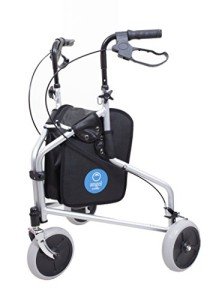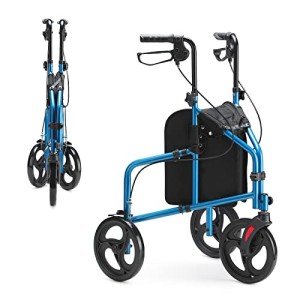
Understanding Rollators with Brakes: A Comprehensive Guide
As people age or experience mobility challenges, daily jobs can end up being significantly hard. A rollator with brakes is a mobility aid designed to enhance independence and safety for users. These tools not just provide assistance while walking however also come geared up with brakes that ensure stability and control. This article looks into the features, benefits, and factors to consider for choosing a rollator with brakes, along with frequently asked concerns to help prospective users make notified choices.

What is a Rollator?
A rollator is a mobility aid that generally includes a wheeled frame with handgrips, a seat, and, most importantly, brakes. Developed for people who need some support while walking, rollators provide stability, assistance, and a practical method to rest when needed.
Secret Features of Rollators
- Wheels: Most rollators have 4 wheels, which permit smoother motion over numerous terrains.
- Brakes: Handles linked to brakes allow users to manage speed and stop securely when needed.
- Seat: A built-in seat uses a choice for users to rest when fatigued.
- Storage: Many designs include baskets or pouches for bring personal items.
Benefits of Using a Rollator with Brakes
Utilizing a rollator with brakes provides various benefits, including:
- Enhanced Safety: The brakes provide stability, preventing falls.
- Self-reliance: Users can move about without support, promoting autonomy.
- Convenience: Built-in storage allows individuals to bring their personal belongings easily.
- Versatility: Suitable for both indoor and outdoor use.
Types of Rollators with Brakes
Rollators come in various designs to accommodate different user needs. The following are typical kinds of rollators with brakes:
- Standard Rollators: Equipped with four wheels, these appropriate for a lot of users who require fundamental support.
- Heavy-Duty Rollators: Designed for bigger individuals, these rollators include enhanced frames to provide dependable support.
- Compact Rollators: Lightweight and foldable, compact rollators are ideal for travel.
- Three-Wheel Rollators: A versatile choice for steering tight areas, three-wheel models provide ease of movement.
| Type of Rollator | Secret Features | Best Suited For |
|---|---|---|
| Standard Rollator | Four wheels, standard performance | General users |
| Heavy-Duty Rollator | Reinforced frame, durable materials | Bigger people |
| Compact Rollator | Lightweight, foldable style | Travel and portability |
| Three-Wheel Rollator | Smaller sized turning radius, simple mobility | Limited spaces |
Elements to Consider When Choosing a Rollator with Brakes
Picking the best rollator needs consideration of numerous aspects. Here are essential elements to remember:
- Weight Capacity: Verify the rollator's weight limitation to guarantee it is safe for the user.
- Manage Height: Adjustable deals with enable modification to fit individual height requirements.
- Wheel Size: Larger wheels carry out better on unequal surfaces, while smaller sized wheels offer agility in tight spaces.
- Folding Ability: If travel is a consideration, search for a design that is simple to fold and store.
- Braking Mechanism: Different models may include different braking systems (e.g., push-to-lock, pull-to-release). Choose one that aligns with user convenience.
Maintenance Tips for Rollators with Brakes
Proper upkeep makes sure longevity and optimal performance. Follow these guidelines to keep a rollator in excellent condition:
- Regular Cleaning: Wipe down the frame and check for collected dirt and particles.
- Check Wheels: Ensure wheels are devoid of blockage and are effectively pumped up if pneumatic.
- Test Brakes: Regularly inspect if brakes engage and disengage efficiently.
- Adjust Handles: Make periodic modifications to make sure the manage height remains appropriate for the user.
Regularly Asked Questions (FAQs)
Q1: Are rollators suitable for outdoor use?A1: Yes
, numerous rollators are created for both indoor and outdoor use. Those with larger wheels tend to carry out better on irregular surfaces.
Q2: Can rollators fold for easy storage?A2: Most rollators feature a folding feature, making them easy to store and transport. Q3: How do I understand if a rollator is
safe for me?A3: Ensure the weight capability satisfies your needs,
and adjust the manage height for appropriate ergonomics. Consulting a doctor for suggestions is also advisable. Q4: Can I use a rollator with brakes on stairs?A4: Rollators are not created
for use on stairs. For stair navigation,
people must seek other techniques of support, like hand rails or stair lifts. Q5: How do I look after a Rollator With Brakes (additional hints)?A5: Regular cleansing, inspecting for wear and tear, and checking the braking system are important steps for upkeep. Rollators with brakes represent an important mobility aid for people seeking enhanced self-reliance and safety. As users evaluate their choices
, comprehending the various types, functions, and maintenance requirements will guarantee they select the very best rollator for their needs. With proper care and use, a rollator can substantially improve one's mobility, contributing to better quality of life and higher flexibility in everyday activities.